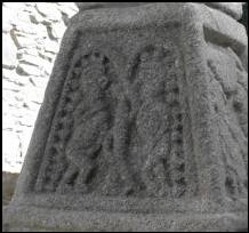
This page depictions images on some of the Irish High Crosses of the story of The Fall as told in Genesis chapter three. According to Peter Harbison, (The High Crosses of Ireland) this image appears in some form on 30 different crosses. Below we examine just a few of these. The image to the left is on the Moone High Cross, County Kildare.
The Text: Now the serpent was more crafty than any other wild animal that the LORD God had made. He said to the woman, "Did God say, 'You shall not eat from any tree in the garden'?" 2 The woman said to the serpent, "We may eat of the fruit of the trees in the garden; 3 but God said, 'You shall not eat of the fruit of the tree that is in the middle of the garden, nor shall you touch it, or you shall die.'"4 But the serpent said to the woman, "You will not die; 5 for God knows that when you eat of it your eyes will be opened, and you will be like God, knowing good and evil." 6 So when the woman saw that the tree was good for food, and that it was a delight to the eyes, and that the tree was to be desired to make one wise, she took of its fruit and ate; and she also gave some to her husband, who was with her, and he ate.7 Then the eyes of both were opened, and they knew that they were naked; and they sewed fig leaves together and made loincloths for themselves. Gen 3:1-7 (NRSV)
Interpreting The Fall
The traditional interpretation of The Fall is that in the actions of Adam and Eve all human kind moved from innocence to sin; from obedience to disobedience. The following illustrate the dominant theology of the time.
Saint Ambrose (c.a. 337-397), bishop of Milan and one of the four original doctors of the church , taught what has come to be called “original sin.” “Ambrose . . . Taught that through the sin of the first man, Adam, all Adam’s descendants come into the world tainted with sin.” (Latourette , 177)
Saint Augustine (354-430), bishop of Hippo “taught, the first man, Adam, fell into sin. This was not primarily a yielding to sub-rational instincts and emotional drives, as the Greeks would have held, but a choice made deliberately through the use of reason.” (Latourette, 178)
It is these interpretations that would have been in the minds of those who planned the carvings on the Irish High Crosses. Modern, progressive exegesis does not always follow this interpretation.
The Fall on the Irish High Crosses
Peter Harbison, in The High Crosses of Ireland offers the following division of the story as seen on the high crosses: Eve gives the Apple to Adam, Adam and Eve Knowing their Nakedness, The Lord Reproves Adam, and Adam and Eve at Labour.
Only the first two of these categories definitely appear on the crosses. On a number of the crosses, as we will see below, the first two categories seem to appear together in the same image.
Harbison’s first category, Eve Gives the Apple to Adam, encompasses both the temptation by the serpent and the act of eating the apple, the result of a successful temptation.
Farther below are several images that focus solely on Adam and Eve Knowing their Nakedness.
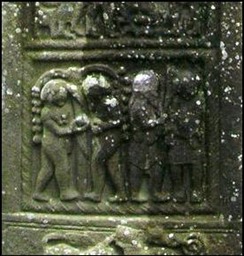
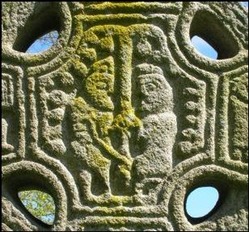
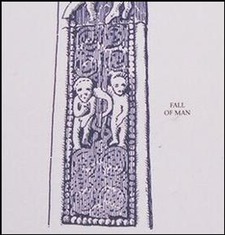
Pictured above [left to right] Monasterboice Cross of Muirdach, County Louth; Castledermot, North Cross, County Kildare; Drumcliff Cross; County Sligo. The third image is from an information sign at the site. Below [right] Moone Cross, County Kildare.
Images of The Fall on the High Crosses of Ireland

It is evident from the four examples offered here that artistic style varies from cross to cross. The basic elements of the image are, however, consistent. We see Adam and Eve, the Tree of the Knowledge of Good and Evil and the Serpent. In most images the apple is also clearly seen.
Monasterboice, Cross of Muirdach: Eve, on the left and Adam on the right, stand under the tree with its fruit hanging down behind each of them. The serpent is coiled around the tree, head facing Eve. Eve hands Adam an apple with her right hand and Adam reaches for it with his left hand. Each, with the other hand, covers their nakedness.
Castledermot North: All the basic elements are present in this scene. In this panel there is no indication Adam and Eve have yet recognized their nakedness. Stylistically the figures are crude. The figure on the right, probably Adam, appears to be seated.
Drumcliff: This rendering shows both figures in a frontal position. Eve on the left seems to be eating the apple. Both Adam and Eve hide their nakedness.
Moone: While Eve, on the left, seems to hold her right hand toward Adam, we cannot see the apple. Nor can we see Adam’s hand reaching to receive it.
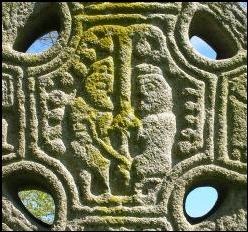
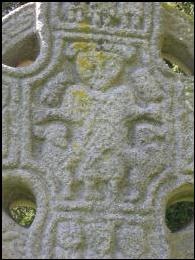
The Relationship of the Fall to the Crucifixion
On two of the crosses where the story of the Fall is depicted, a definite link is made between this event and the Crucifixion of Christ. The Crucifixion appears on the crosses more than any other image, but in these cases it appears opposite The Fall. On the North cross at Castledermot The Fall is on the west face of the head of the cross [left] and the Crucifixion is on the east face [right].
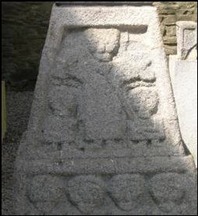
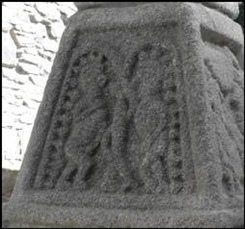
On the upper base of the cross at Moone The Fall appears on the east face [left] and the Crucifixion on the west face [right].
In writing to the church at Corinth about the resurrection the Apostle Paul makes this link. For since death came through a human being, the resurrection of the dead has also come through a human being; for as all die in Adam, so all will be made alive in Christ.” (1 Cor. 15:21-22 NRSV)
Christian theology has traditionally seen the Christ event as the answer to the problem of disobedience and alienation from God symbolized by The Fall.
Below [left to right] Kells Market Cross, east face, County Meath; Kells West Cross, west face, County Meath; and Kells Patrick and Columba Cross, east face, County Meath.
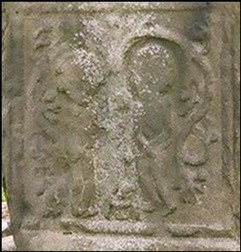

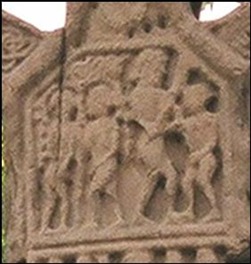
Adam and Eve Know Their Nakedness
As you will note, the three images above are all found on High Crosses at Kells. Each depicts Adam and Eve under the Tree of the Knowledge of Good and Evil with serpent coiled around the trunk of the tree. The difference between these images and those above of Eve Giving Adam the Apple is that here both Adam and Eve use both hands to cover their nakedness. This is a snapshot of the first result of their disobedience.
Adam and Eve with Cain and Abel
In three of the images above the scene of The Fall is in the same panel with Cain Killing Abel. [Monasterboice Cross of Muirdach, County Louth; Kells West Cross, west face, County Meath; and Kells Patrick and Columba Cross, east face, County Meath] Peter Harbison writes that Cain Killing Abel was a popular image on the Irish High Crosses. As is true of many of the images from the Hebrew scriptures, this scene was seen as prefiguring of the New Testament. Abel was the first innocent to be slain. Christ was also an innocent victim. Thus Abel prefigures Christ. (Harbison, 194)
References cited:
Harbison, Peter; The High Crosses of Ireland: An Iconographical and Photographic Survey, Dr. Rudolf Habelt GMBH, Bonn, 1992. Volume 1
Latourette, Kenneth Scott, A History of Christianity, Volume 1: to AD 1500, Harper and Row, New York, 1975.
Roe, Helen M., The High Crosses of Kells, Meth Archaeological and Historical Society, 1988.